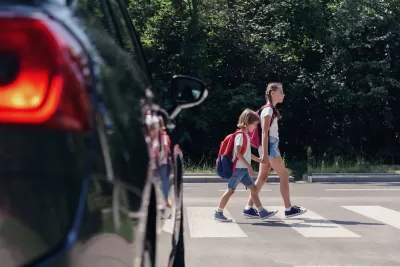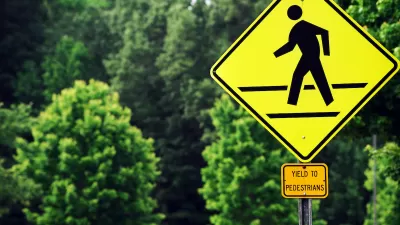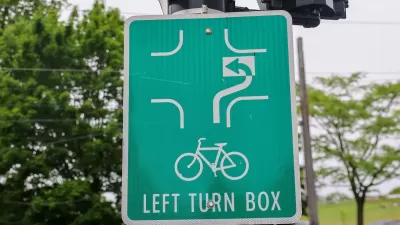The guiding document for U.S. road design is starting to recognize the needs of people walking and biking, but safe streets advocates say more significant changes are needed to reduce the high number of pedestrian deaths and improve connectivity for all road users.

A powerful federal document that dictates street design is getting a makeover after years of advocacy, reports Josh Naramore in Streetsblog USA.
The Manual on Uniform Traffic Control Devices (MUTCD), first created in 1935, governs all road markings, speed limits, road signage, and traffic signals in the United States. The document has rarely been updated, perpetuating outdated and dangerous road design practices. As Naramore explains, “The MUTCD prioritizes moving private vehicles at maximum efficiency and speed above all other goals, including safety, sustainability, and access for people walking, biking, in a wheelchair, or on a bus.”
The December 2023 update to the document signaled a major shift in priorities, focusing for the first time on the safety of pedestrians and other vulnerable road users. However, Naramore argues that it “fails to include many necessary reforms that would create comprehensively safe streets.”
While the update encourages traffic calming and mechanisms that prevent speeding, makes it easier to install crosswalks, and explicitly allows the use of painted bike and transit lanes, it falls short in some areas, such as failing to recognize that not all groups of pedestrians — such as children — can be expected to act “alertly and attentively.” Meanwhile, “To justify installing pedestrian signals, the MUTCD still requires a very high volume of people to be crossing an unprotected intersection — or that transportation officials wait for multiple traffic injuries or deaths to occur.”
Naramore also expresses concern about the MUTCD’s new language on autonomous vehicles, which “normalizes nascent driverless technology without understanding its consequences.” Naramore suggests that safe streets advocates must continue promoting changes that are more in line with the Safe System approach and truly recognize how road design impacts the safety of people inside and outside of cars.
FULL STORY: The 1,000-Page Document That Decides Your Street Designs Just Got a Refresh

Maui's Vacation Rental Debate Turns Ugly
Verbal attacks, misinformation campaigns and fistfights plague a high-stakes debate to convert thousands of vacation rentals into long-term housing.

Planetizen Federal Action Tracker
A weekly monitor of how Trump’s orders and actions are impacting planners and planning in America.

San Francisco Suspends Traffic Calming Amidst Record Deaths
Citing “a challenging fiscal landscape,” the city will cease the program on the heels of 42 traffic deaths, including 24 pedestrians.

Study: Anti-Homelessness Laws Don’t Work
Research shows that punitive measures that criminalized unhoused people don’t help reduce homelessness.

In U.S., Urban Gondolas Face Uphill Battle
Cities in Latin America and Europe have embraced aerial transitways — AKA gondolas — as sustainable, convenient urban transport, especially in tricky geographies. American cities have yet to catch up.

Detroit Says Problems With Property Tax Assessments are Fixed. Advocates Disagree.
With higher-valued properties under assessed and lower-valued properties over assessed, advocates say there's still a problem with Detroit's property tax system.
Urban Design for Planners 1: Software Tools
This six-course series explores essential urban design concepts using open source software and equips planners with the tools they need to participate fully in the urban design process.
Planning for Universal Design
Learn the tools for implementing Universal Design in planning regulations.
Heyer Gruel & Associates PA
JM Goldson LLC
Custer County Colorado
City of Camden Redevelopment Agency
City of Astoria
Transportation Research & Education Center (TREC) at Portland State University
Jefferson Parish Government
Camden Redevelopment Agency
City of Claremont





























